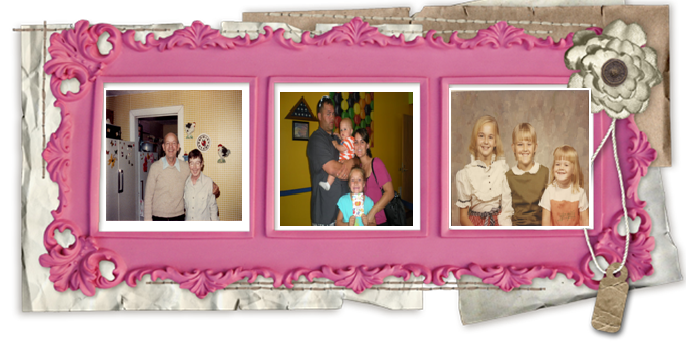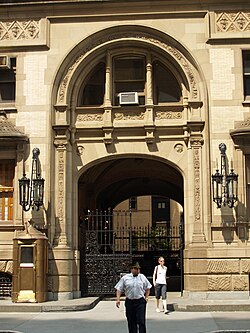The architectural firm of Henry Janeway Hardenbergh was commissioned to create the design for Edward Clark, head of the Singer Sewing Machine Company. The firm also designed the Plaza Hotel.
The building's high gables and deep roofs with a profusion of dormers, terracotta spandrels and panels, niches, balconies, and balustrades give it a North German Renaissance character, an echo of a Hanseatic townhall. Nevertheless, its layout and floor plan betray a strong influence of French architectural trends in housing design that had become known in New York in the 1870s.
According to often repeated stories, the Dakota was so named because at the time it was built, the Upper West Side of Manhattan was sparsely inhabited and considered as remote as the Dakota Territory. However, the earliest recorded appearance of this account is in a 1933 newspaper story. Now Central Park West is among the most desirable and expensive Real Estate locations, aside from the Upper East Side It is more likely that the building was named "The Dakota" because of Clark's fondness for the names of the new western states and territories.High above the 72nd Street entrance, the figure of a Dakota Indian keeps watch.
The Dakota was designated a New York City Landmark in 1969,was added to the National Register of Historic Places in 1972, and was declared a National Historic Landmark in 1976.
The Dakota is square, built around a central courtyard. The arched main entrance is a porte cochère large enough for the horse-drawn carriages that once entered and allowed passengers to disembark sheltered from the weather. Many of these carriages were housed in a multi-story stable building built in two sections at the southwest corner of 77th Street and Amsterdam Avenue, where elevators lifted them to the upper floors. The "Dakota Stables" building was in operation as a garage until February 2007, when it was slated to be transformed by the Related Companies into a condominium residence. Since then, the large condominium building "The Harrison" occupies its spot. As of 2011, there is no onsite commemoration of the stable building having ever existed.
The general layout of the apartments is in the French style of the period, with all major rooms not only connected to each other, in enfilade, in the traditional way, but also accessible from a hall or corridor, an arrangement that allows a natural migration for guests from one room to another, especially on festive occasions, yet gives service staff discreet separate circulation patterns that offer service access to the main rooms. The principal rooms, such as parlors or the master bedroom, face the street, while the dining room, kitchen, and other auxiliary rooms are oriented toward the courtyard. Apartments thus are aired from two sides, which was a relative novelty in Manhattan at the time. (The Stuyvesant building, which was built in 1869, a mere ten years earlier, and which is considered Manhattan's first apartment building in the French style, has many apartments which have windows to one side only.) Some of the drawing rooms are 49 ft (15 m) long, and many of the ceilings are 14 ft (4.3 m) high; the floors are inlaid with mahogany, oak, and cherry (although in the apartment of Clark, the building's founder, famously, some floors were inlaid with sterling silver).
Originally, the Dakota had sixty-five apartments with four to twenty rooms, no two being alike. These apartments are accessed by staircases and elevators placed in the four corners of the courtyard. Separate service stairs and elevators serving the kitchens are located in mid-block. Built to cater for the well-to-do, The Dakota featured many amenities and a modern infrastructure that was exceptional for the time. The building has a large dining hall; meals also could be sent up to the apartments by dumbwaiters. Electricity was generated by an in-house power plant and the building has central heating. Beside servant quarters, there was a playroom and a gymnasium under the roof. In later years, these spaces on the tenth floor were converted into apartments for economic reasons. The Dakota property also contained a garden, private croquet lawns, and a tennis court behind the building between 72nd and 73rd Streets.
The Dakota was a huge social success from the very start (all apartments were let before the building opened), but it was a long-term drain on the fortune of Clark (who died before it was completed) and his heirs. For the high society of Manhattan, it became fashionable to live in the building, or at least to rent an apartment there as a secondary city residence, and The Dakota's success prompted the construction of many other luxury apartment buildings in Manhattan.
Death of John Lennon
The building was the home of former Beatle John Lennon from 1973 on, and was the location of Lennon's murder by Mark David Chapman on December 8, 1980. As of 2010, Lennon's wife and widow, Yoko Ono, still has several apartments in the building. The Strawberry Fields memorial was laid out in memory of Lennon in Central Park directly across Central Park West. Every year, Ono marks the anniversary of Lennon's death with a now-public pilgrimage to the memorial, and by placing a single lit candle in the window of one of her apartments.In popular culture
- In the film Rosemary's Baby, the Dakota is used for exterior shots of "The Bramford," the apartment building where several of the characters live.
- It is an important element in the novel Time and Again.
- The song 20 Years In the Dakota by Hole discusses Yoko Ono's life in the building after John Lennon's death; it was released on their 1997 compilation album, My Body, the Hand Grenade.
- Yoko Ono, John Lennon's wife, still owns an apartment in the Dakota and can be seen strolling in Strawberry Fields on occasion.
- In the 2001 Cameron Crowe film Vanilla Sky, the main character of David Aames (Tom Cruise) is shown to own two apartments in the building, though only exterior shots were used.
- It is the home of Tsukasa Domyouji, from the popular 2007 Japanese live-action drama Hana Yori Dango Returns.
- It is one of several New York City residences that Special Agent Aloysius X.L. Pendergast, a recurring character in novels written by Douglas Preston and Lincoln Child, is known to reside in.
- It is the subject of the 2012 documentary Dreaming of the Dakota by director Scott Cardinal.
- It is the home of Windsor Horne Lockwood III in the Myran Bolitar series written by Harlan Coben.
- It is a main staging point of a Lee Child novel called The Hard Way, which features his renown hero, Jack Reacher.
- It is the primary setting of James Patterson's 2012 novel, Confessions of a Murder Suspect.
Notable residents
- This is an incomplete list, which may never be able to satisfy particular standards for completeness. You can help by expanding it with reliably sourced entries.
- John Angelo, financier
- Lauren Bacall, actress
- Connie Chung, newscaster
- Rosemary Clooney singer, actress
- Harlan Coben, author
- José Ferrer, actor
- Roberta Flack, singer. Flack lives next door to Yoko Ono.
- Judy Garland, actress
- Lillian Gish, actress
- Boris Karloff, actor
- John Lennon, musician and composer - Lennon owned five apartments in The Dakota.
- Sean Lennon, singer
- Warner LeRoy, producer and restaurateur
- John Madden, football coach and commentator. Madden bought his apartment from Gilda Radner
- Rudolf Nureyev, dancer
- Joe Namath, football player
- Yoko Ono, artist
- Jack Palance, actor
- Maury Povich, television host
- Gilda Radner, comedian
- Jason Robards, actor
- Jane Rosenthal, film producer
- Robert Ryan, actor. Robert Ryan initially sublet his apartment (#72) to John Lennon and Yoko Ono. They eventually purchased his former apartment after his death.
- Michael Wager, actor



 With both engines out, a cool-headed pilot,
With both engines out, a cool-headed pilot,